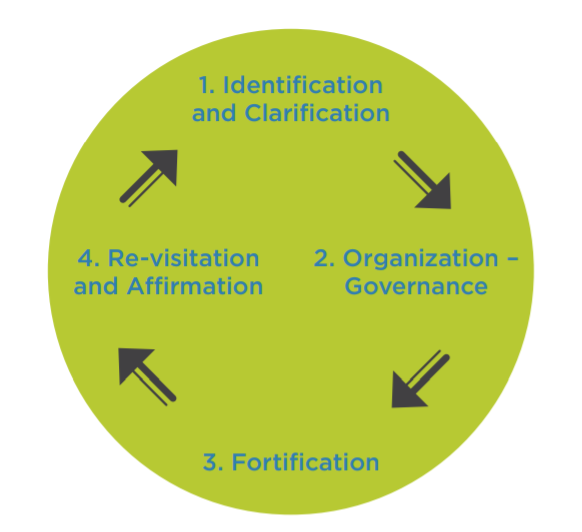Family Culture: Creating a Resilient Family Tree

Courtesy of Johannes Plenio from Pexels
Courtesy of Johannes Plenio from Pexels
This blog post is excerpted from the Passages Issues Brief Family Culture: Creating a Resilient Family Tree. For more information about family culture, please register for our Family Identity and Culture Webinar on February 11, 2021.
Family connectedness, not money, has the greatest influence on multi-generational family continuity. But when many think about legacy, it’s often in the context of multi-generational financial wealth. Money, though, masks what people are really interested in passing to future generations of their family. Instead of being the primary focus, financial assets should be viewed as an enabler to the bigger objectives: HAPPINESS and COLLECTIVE CONNECTION.
Isn’t that what we really want for ourselves and for our family?
But happiness and collective connection are intangible and can be very challenging goals to manage. So, rather than focusing on happiness when we think about our personal or family legacy, we put most of our attention on passing along financial wealth and hope that, due in part to whatever monetary boost we pass to our heirs, it will help them find happiness on their own.
Authors’ Reflections
In our personal experiences working with families—and as members of two different families that have each maintained a collective identity through more than 275 years—we recognize some commonalities in our own families and other families that have achieved multi-generational cohesiveness. The observations reflected on these pages outline the core elements we believe are both relevant and critical for those seeking multi-generational continuity. Multi-generational continuity is not a product of money. Rather, it’s a product of family connection.
Money, in and of itself, will not bind people together for more than a generation or two. Common identity, shared goals, an appreciation of shared core values, and experiences are what create durable family connections. Money can support these connections, but the assets themselves will not replace the hard work required to sustain family identity and connection.
Culture – It’s Alive
The most important factor in maintaining multigenerational connections within your family is a focus on your family culture. Your family’s culture is a living, breathing entity that is reflected by individual and collective behaviors of family members. These behaviors are driven by individual and shared values, spiritual beliefs, economic and social norms, affiliations, experiences, geography, climate, and many other factors. These common elements among family members create a sense of belonging, loyalty and pride that builds resilience. Family folklore, traditions and activities provide the socialization and cultural training for young family members, adopted children, step-children and in-laws. Your family culture is built, sustained and informed by each family member, your nuclear family, your extended family, the community where you live, and the broader society. And because aspects of your family’s culture will shift over time, it’s important to curate those shifts.
Focusing on your family culture doesn’t guarantee your family will sustain a common identity and connection through generational transitions—past performance doesn’t guarantee future returns. But we do know this: families that focus on culture are much more likely to sustain their connections—and their wealth—over time than families focusing exclusively on their money. Jay Hughes, renowned author and pioneer on issues of family wealth, outlines these cultural elements of sustaining family wealth, identifying them as the seven fundamental principles that
guide his work.¹ Taken together, they frame the importance of family culture as a tool for sustaining families across generations.
Do The Work Now
This is important work, and it’s becoming more important with each passing year. Why? The rate and pace of technology has changed expectations of how we work, communicate, and relate to each other. The world feels increasingly smaller as everything from cultural norms to fashion, music, toys and even jokes can be sent anywhere in the world in less than a second. In some ways this shrinking of the world creates more similarity, but it also creates an expectation and practically requires making constant tweaks as norms shift.
It used to be that family culture was more durable when it was rigid. “This is how we do it” makes things easier to control. And before technology
blurred borders and cultural differences across the globe, there was less pressure to change and evolve. Today, thought, it’s unrealistic to shut off
the torrent of pressure to change that comes from the external world. Rather than try to shut it out, identifying what’s core to your family culture will help determine how to remain relevant while also protecting its foundational elements.
Family Culture Cycle
Our observations helped us clarify the process for identifying, solidifying and maintaining family culture: We call this a cycle to recognize that culture is not static. To remain relevant, cultures must evolve and shift over time, and understanding when these shifts are necessary requires sensitive oversight and regular revisiting of each step.
We call this a cycle to recognize that culture is not static. To remain relevant, cultures must evolve and shift over time, and understanding when these shifts are necessary requires sensitive oversight and regular revisiting of each step.
The first step focuses on identifying and agreeing upon the building blocks of the family culture. The second step is designed to establish a system that supports the values and moral code of the family, and it identifies specific ways to socialize and reinforce the key elements that inform the family culture. Fortification refers to the specific activities you choose as a family to orient new members, engage and educate members at different points in life, and build relationships both among and between the different generations. Finally, the re-visitation and affirmation step focuses on stewarding family culture and requires connections across all generations. The family council (see page 7) is responsible for revisiting and affirming the family culture to ensure it remains relevant within the family and also for identifying if/when external counsel may be needed.
Each of these steps in the process are outlined in more detail in the following sections, providing a framework for those who recognize the value in managing and nurturing not just your financial assets but also your human assets.
In the interest of learning and improving on our thinking, we encourage you to share your own experiences and challenge or question the framework. Focusing on this process will support those of you who aspire to create a durable family legacy that sustains both your family members and your financial assets.
¹ Hughes, James E. Jr., Family – The Compact Among Generations, New York, Bloomberg Press, 2007, xvii
Jamie Forbes is the founder and principal of Forbes Legacy Advisors, a philanthropy advising firm for individuals, families and businesses.
Kelly Nowlin, is a trustee at the Surdna Foundation and NCFP Fellow.
The views and opinions expressed in individual blog posts are those of the author(s) and do not necessarily reflect the official policy or position of the National Center for Family Philanthropy.
